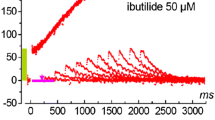Abstract
The mechanism of nicorandil-induced large inward tail current (I tail) in single guinea-pig ventricular cells was investigated using the whole-cell patch-clamp technique. In the presence of 0.5–1.0 mM nicorandil, an activator of adenosine 5′-triphosphate (ATP)-sensitive K+ current (I KATP), a depolarization pulse causing a large outward current was followed by a large inward I tail on the repolarization step to the holding potential at-85 mV. The larger the outward current, the greater the I tail. The amplitude of I tail increased as a single exponential function (τ=74.9 ms) as the duration of preceding depolarization was prolonged. Both the outward current and I tail were inhibited nearly completely after application of glibenclamide (1 μM), a specific blocker of I KATP. Substitution of K+ with Cs+ in both the external and internal solutions resulted in a virtual elimination of I tail. I tail was well preserved under the condition where Ca2+ entry during the preceding depolarization was largely inhibited or where external Na+ was replaced by Li+. A transient positive shift of reversal potential for the net current was observed at the peak of I tail. At 30 mM external K+ concentration, I tail was almost eliminated. From these findings, it is concluded that the I tail is a K+ current associated with an alteration of the K+ equilibrium potential (E K) following a substantial K+ efflux. This E K change is most likely explained by an accumulation of K+in transverse tubules (T-tubules) since I tail was not induced in atrial cells in which T-tubules are poorly developed.
Similar content being viewed by others
References
Arena JP, Kass RS (1990) Potassium sensitivity of delayed rectification in the isolated guinea pig ventricular cell: contribution of extracellular potassium concentration changes. Biophys J 57:137a
Baumgarten CM, Isenberg G (1977) Depletion and accumulation of potassium in the extracellular clefts of cardiac Purkinje fibers during voltage clamp hyperpolarization and depolarization. Pflügers Arch 368:19–31
Baumgarten CM, Isenberg G, McDonald TF, Ten Eick RE (1977) Depletion and accumulation of potassium in the extracellular clefts of cardiac Purkinje fibers during voltage clamp hyperpolarization and depolarization: experiments in sodium-free bathing media. J Gen Physiol 70:149–169
Cleemann L, Morad M (1976) Extracellular potassium accumulation and inward-going potassium rectification in voltage clamped ventricular muscle. Science 191:90–92
Colquhoun D, Neher E, Reuter H, Stevens CF (1981) Inward current channels activated by intracellular Ca in cultured cardiac cells. Nature 294:752–754
Drewnowska K, Baumgarten CM (1991) Regulation of cellular volume in rabbit ventricular myocytes: bumetanide, chlorothiazide and ouabain. Am J Physiol 260:C122-C131
Egan TM, Noble D, Noble SJ, Powell T, Spindler AJ, Twist VW (1989) Sodium-calcium exchange during the action potential in guinea-pig ventricular cells. J Physiol (Lond) 411:639–661
Ehara T, Noma A, Ono K (1988) Calcium-activated non-selective cation channel in ventricular cells isolated from adult guinea-pig hearts. J Physiol (Lond) 403:117–133
Escande D, Thuringer D, Le Guern S, Courteix J, Laville M, Cavero I (1989) Potassium channel openers act through an activation of ATP-sensitive K+ channels in guinea-pig cardiac myocytes. Pflügers Arch 414:669–675
Fosset M, De Weille JR, Green RD, Schmid-Antomarch H, Lazdunski M (1988) Antidiabetic sulfonylureas control action potential properties in heart cells via high affinity receptors that are linked to ATP-dependent K+ channels. J Biol Chem 263:7933–7936
Giles W, Shimoni Y (1989) Slow inward tail currents in rabbit cardiac cells. J Physiol (Lond) 417:447–463
Hamill OP, Marty A, Neher E, Sakmann B, Sigworth FJ (1981) Improved patch-clamp techniques for high resolution current recording from cells and cell-free membrane patches. Pflügers Arch 391:85–100
Hiraoka M, Fan Z (1989) Activation of ATP-sensitive outward K+ current by nicorandil (2-nicotinamidoetyl nitrate) in isolated ventricular myocytes. J Pharmacol Exp Ther 250:278–285
Hume JR, Uehara A (1986) “Creep currents” in single frog atrial cells may be generated by electrogenic Na/Ca exchange. J Gen Physiol 87:857–884
Kline RP, Cohen IS (1984) Extracellular [K+] fluctuations in voltage-clamped canine cardiac Purkinje fibers. Biophys J 46:663–668
Nakayama K, Fan Z, Marumo F, Hiraoka M (1990) Interrelation between pinacidil and intercellular ATP concentrations on activation of the ATP-sensitive K+ current in guinea pig ventricular myocytes. Circ Res 67:1124–1133
Noma A (1983) ATP-regulated K+ channels in cardiac muscle. Nature 305:147–148
Noma A, Shibazaki T (1985) Membrane current through adenosine-triphosphate-regulated potassium channels in guinea-pig ventricular cells. J Physiol (Lond) 363:463–480
Sato R, Noma A, Kurachi Y, Irisawa H (1985) Effects of intracellular acidification on membrane currents in ventricular cells of the guinea pig. Circ Res 57:553–561
Soejima M, Noma A (1984) Mode of regulation of the ACh-sensitive K-channel by the muscarinic receptor in rabbit atrial cells. Pflügers Arch 400:424–431
Sommer JR (1982) Ultrastructural considerations concerning cardiac muscle. J Mol Cell Cardiol [Suppl 3] 14:77–83
Sommer JR, Johnson EA (1968) Cardiac muscle: A comparative study of Purkinje fibers and ventricular fibers. J Cell Biol 36:497–526
Yazawa K, Kaibara M, Ohara M, Kameyama M (1990) An improved method for isolating cardiac myocytes useful for patch-clamp studies. Jpn J Physiol 40:157–163
References
Bers DM (1991) Major cellular structures involved in excitation-contraction coupling. In: Bers DM (ed) Excitation-contraction coupling and cardiac contractile force. Kluwer Academic, Dordrecht Boston London, pp 1–16
Boyett MR, Fedida D (1988) A computer simulation of the effect of heart rate on ion concentrations in the heart. J Theor Biol 132:15–27
Kakei M, Noma A, Shibazaki T (1985) Properties of adenosinetriphosphate-regulated potassium channels in guinea-pig ventricular cells. J Physiol (Lond) 363:441–462
Author information
Authors and Affiliations
Rights and permissions
About this article
Cite this article
Yasui, K., Anno, T., Kamiya, K. et al. Contribution of potassium accumulation in narrow extracellular spaces to the genesis of nicorandil-induced large inward tail current in guinea-pig ventricular cells. Pflügers Arch. 422, 371–379 (1993). https://doi.org/10.1007/BF00374293
Received:
Revised:
Accepted:
Issue Date:
DOI: https://doi.org/10.1007/BF00374293




